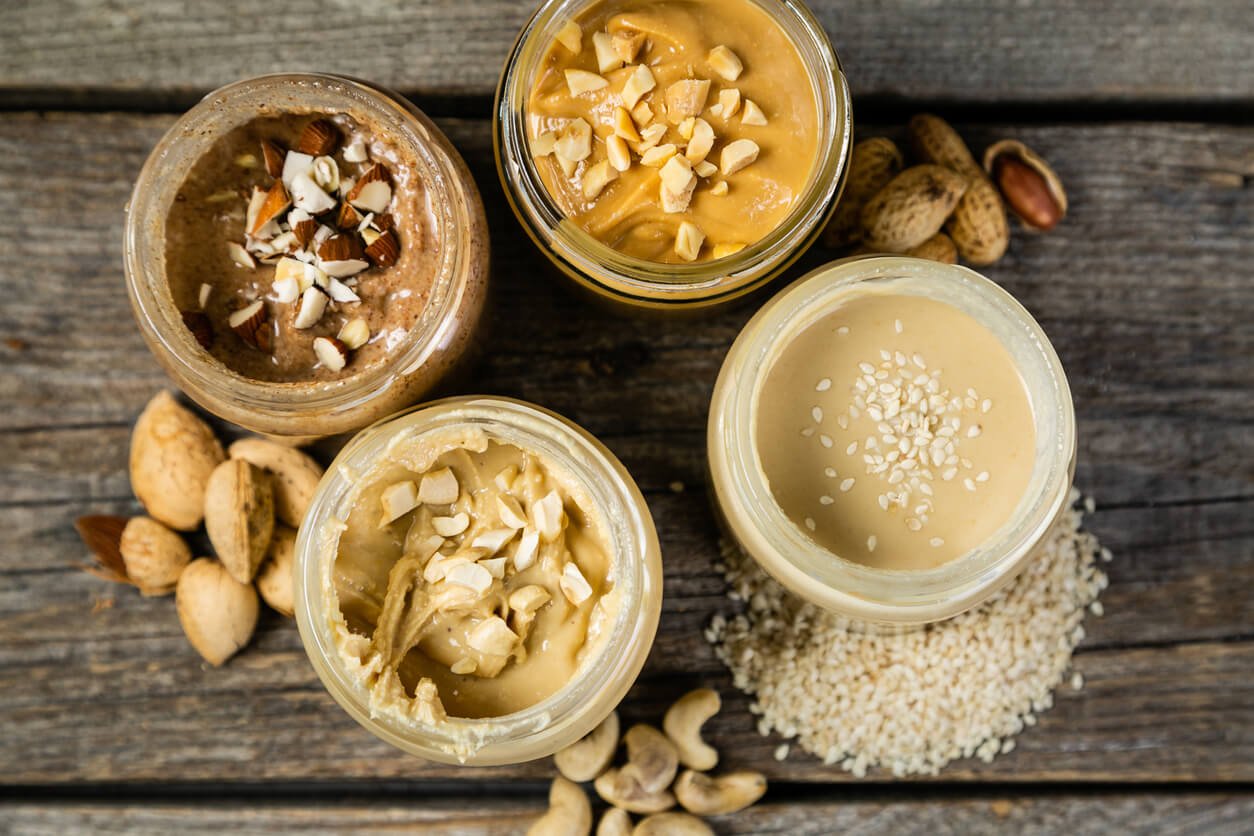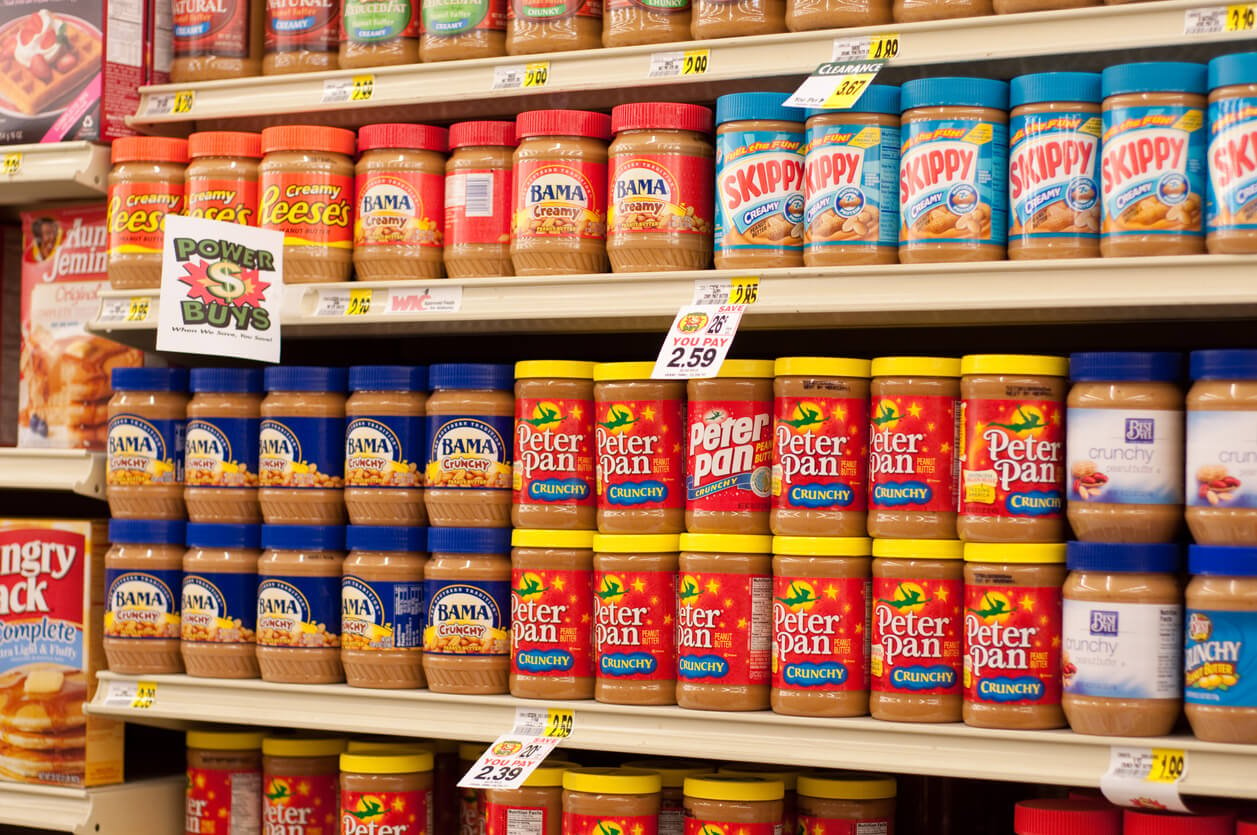You can make nut butter or seed butter out of pretty much any food that’s eaten like
a nut or seed. The most common, of course, is peanut butter, which isn’t a nut at all, but a legume.I’ve known this for years, but only in writing this article did I realize that I wasn’t actually sure about the difference. It turns out that a nut is a fruit with a single seed, while legumes are fruits with multiple seeds. So almonds, walnuts, and hazelnuts are all single inside their hulls, while peanuts typically occur in pairs or even trios inside their shells, more like their legume siblings peas, beans, and lentils.
Nuts
Now you know why peanuts aren’t botanically considered to be nuts. But along with peanuts, almost any nut can be turned into a nut butter, including almonds, cashews, pecans, hazelnuts, pistachios, Brazil nuts, walnuts, and macadamia nuts.
Seeds
What about seeds? Nuts have seeds, but aren’t seeds? Oh dear, more taxonomic confusion. While not getting deep into the biology of plant reproduction (this is a family-friendly website, after all), we can keep it simple by saying that nuts have hard shells (called pericarps) that we have to work to crack open, while seeds are encased in seed coats that are relatively easy to remove. Sunflowers blur the line, but in many cultures, (including American baseball) popping handfuls of sunflower seeds in the mouth and expertly spitting out the shells is a fine art. No nutcracker required.
There are a bunch of seeds that are commonly made into seed butters, like sunflower, pumpkin, sesame (it even has its own special name: tahini), poppy, watermelon, hemp, and flax. One seed hasn’t yet made the cut, but is often included whole in seed butter mixtures: chia.
Seed butters tend to have stronger flavors than nut butters and often benefit from being blended with other seeds or nuts, rather than remaining as a single seed variety. And seed-only butters are often popular alternatives for people with nut allergies.
Nut & Seed Butter Nutrition

Perhaps unsurprisingly, nut and seed butters have a similar nutritional profile to their whole food forms. Nuts and seeds are good sources of plant-based protein, which is one reason that Dr. John Harvey Kellogg, 19th-century health food proponent and plant-based advocate, pushed for the commercial processing of peanuts into peanut butter to replace cow butter in the American diet.
Nuts and seeds are also high in fat, which from their perspective provides food for the growing plant embryo, and from our perspective, makes them creamy and delicious. The majority of the fats are what are commonly considered the “good kinds,” poly- and monounsaturated — although some do contain small amounts of problematic saturated fats. A few kinds of seeds, such as chia and flax, are also rich sources of omega-3 fatty acids.
Nuts and seeds, like many whole plant foods, are high in fiber and rich in minerals like magnesium and manganese. They’re also phytonutrient powerhouses, containing tocopherols, phytosterols, vitamin E, vitamin B6, folate, and phenolic compounds. And Brazil nuts are fantastically high in selenium.
Some nuts are more nutritionally dense than others, as you can see in this nutritional comparison table of some of the most popular nut and seed butters. All nuts (other than chestnuts) are high in fat and calories. On the upside, their high fat and calorie content makes them a good substitute for dairy in some recipes. And they can be a replacement for butter, or used in place of bottled oils, for baked goods. On the upside of that upside, most nuts and seed butters are much lower in saturated fat than dairy. For example, an ounce of peanut butter contains 2.9 grams of saturated fat, which is less than half the amount in an ounce of cheddar cheese.
The downside of all that fat is, that’s a lot of fat. And since fats are more than twice the caloric density of carbohydrates and proteins, that translates into a high-calorie content. If you’re trying to keep off excess weight, or wanting to follow a low-fat diet, you may want to watch the serving sizes of your nuts, seeds, and seed and nut butters.
Why Make Your Own Nut or Seed Butter

With all those convenient commercial jars of seed or nut butters available in stores, why bother making your own?
1. Control the ingredients
One big reason is to keep out ingredients that can harm your health and the environment. The mainstream brands of peanut butter, like Skippy and Jif, for example, contain added sugar and salt, as well as GMO oils.
The most popular added oil, palm oil, keeps the natural peanut oil from separating, so you don’t have to stir the jar’s contents before spreading. That’s a nice feature, but the palm oil industry is responsible for some of the world’s worst environmental damage, as well as racial and economic injustices, since it developed into an international power in the late 19th century. (If you want motivation to stop eating foods containing palm oil, check out the book Planet Palm: How Palm Oil Ended Up in Everything — and Endangered the World, by Jocelyn Zuckerman.)
2. Cut down on plastic
Another reason to make your own is that many commercial nut butters are sold in plastic jars. There is concern that the plasticizers and chemicals like BPA (in the plastic jars and lids) could leach into the food.
3. Save money
Another consideration is price. With the exception of peanut butter, most other commercial nut and seed butters can get expensive. Peanuts are the cheapest option because they require less water and are less expensive to grow than tree nuts. According to the National Peanut Board, admittedly not the most neutral source, growing an ounce of peanuts requires 4.7 gallons of water, compared to 80.4 and 73.5 gallons for shelled almonds and walnuts, respectively. Being legumes, peanuts also replenish soil nitrogen, thus restoring fertility without the need for large quantities of fertilizer. So farmers can pass along all these savings to you.
Whatever the nuts or seeds cost, commercial butters add manufacturing and marketing costs (not to mention profit) on top. So no matter what nut or seed (or legume) you use, making your own butter will probably end up being cheaper than buying it.
One blogger calculated the savings of homemade vs. commercial almond butter over the course of a year, and found that a family consuming three pounds of almond butter a week (which is an awful lot of almond butter, unless you’re the Duggars) could save precisely $954.72 by grinding their own.
4. Get creative
Another reason to go the homemade route is to indulge your inner chef. You can get creative with taste and texture and produce the seed butter or nut butter mix that you and yours prefer. Of course, your own nut and seed butter ingredient lists will be simpler and healthier than store-bought (unless you add things like rapeseed oil or mono and diglycerides, which, to be fair, you’ll be hard-pressed to find at your local natural foods store). But that leaves room for some cool added flavors. Here’s a shortlist to get you inspired:
- Cocoa powder
- Natural sweeteners like stevia, monk fruit, and date sugar
- Spices like chile powder, cinnamon, and cardamom
- Vanilla extract
- Lemon zest
- Additional nuts or seeds to boost nutrition or add a different flavor
And since your hand is on the food processor or blender button, you get to determine exactly how smooth or crunchy the texture will be.
How to Make Nut or Seed Butter

Your first decision is whether to roast your nuts and seeds, or go the raw route. If raw, will you grind the nuts and seeds as they are, or soak or sprout them first? Soaking them in water for a few hours, or overnight, will help you remove any paper skins, like those on peanuts and almonds, and give your finished butter a creamier texture. And sprouting nuts and seeds provides added nutritional benefits.
On the other hand, even lightly roasting helps to release the natural oils in nuts and seeds, which makes them easier to blend — and can bring out their natural flavor. It also makes your home smell like a made-for-television Thanksgiving movie, especially the ones where a jaded, burned-out ad agency executive moves to New Hampshire to take care of her convalescing mother and discovers the joys of family, romance, and wood-burning stoves.
Then comes the easy part: toss the nuts or seeds into a food processor or blender (it’s a bit like the scenic route versus the autobahn, but both will get you there) along with any additional ingredients (salt is always optional).
Blend until the mixture reaches your desired consistency, and then store your butter in an airtight container in the refrigerator. You can use a mason jar, or any other glass container. Avoid plastic, especially if the friction from blending or processing has heated up the butter. Refrigerated, the natural nut and seed butter can stay fresh for three to four weeks.
How to Use Nut and Seed Butters

Once you’ve got your jar of seed butter or nut butter lounging comfortably in the fridge, what then? I’d recommend that, most of the time, you avoid the strategy of eating all of it directly from the jar with a spoon (or worse, your fingers). That leaves several perfectly good options for how to use your seed and nut butters:
- Spread it on whole-grain or sprouted toast — and even crudités like carrots and celery.
- Follow the hallowed PB&J template by spreading it on your favorite bread along with natural fruit preserves or fresh fruit. Elvis may not have known when to stop, but his use of sliced bananas was truly inspired.
- Add oomph to smoothie bowls, açaí bowls, and oatmeal by drizzling your nut butter on top.
- Mix it into smoothies for more creaminess and flavor.
- Drizzle some sweet nut or seed butter over Apple Nachos Supreme, or use it as a dip for other fresh fruit.
- Use it in homemade baked goods.
- Make an Asian stir-fry or plant-based pasta sauce (cashew butter, in particular, makes a good base for a cream sauce).






Комментариев нет:
Отправить комментарий